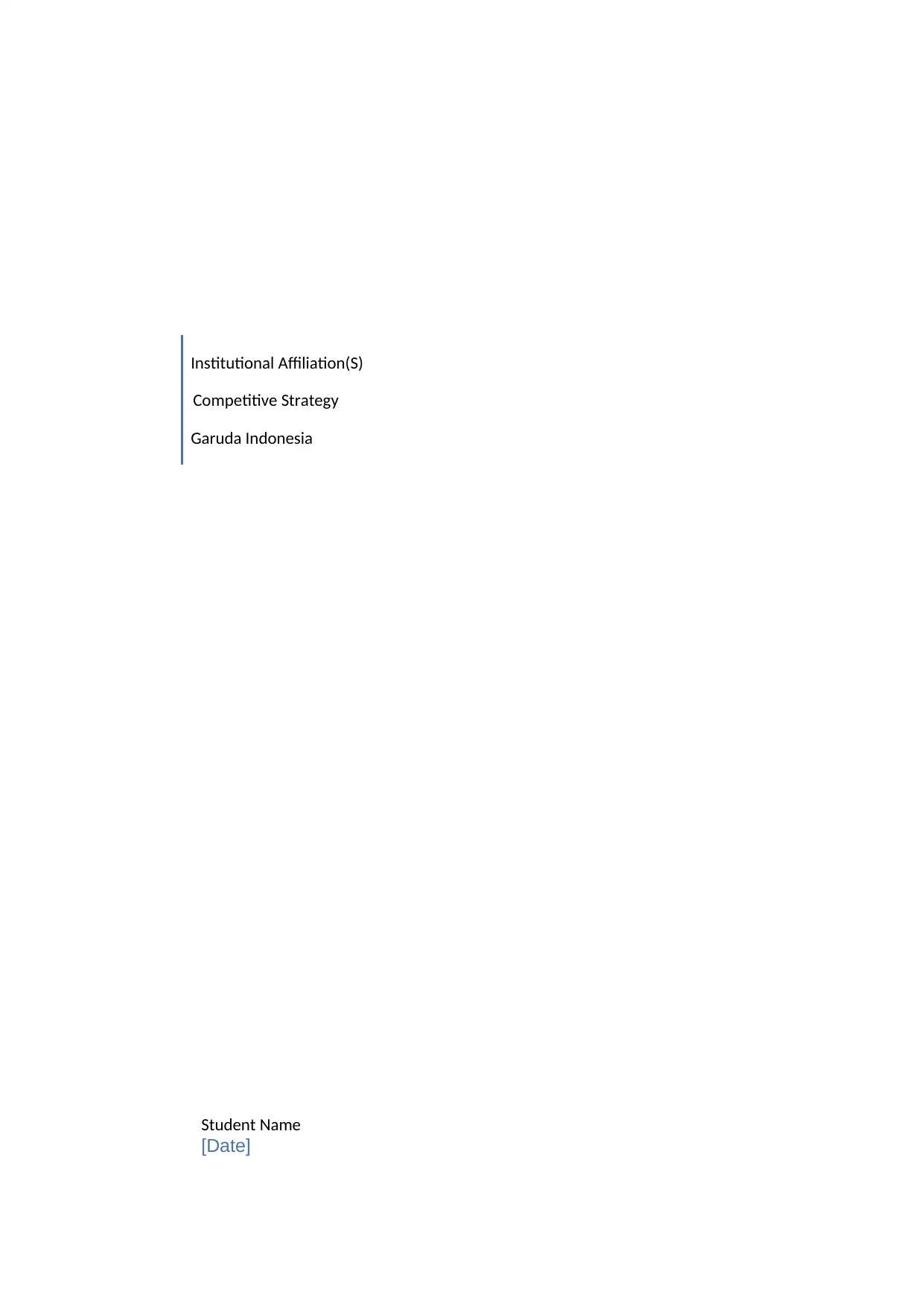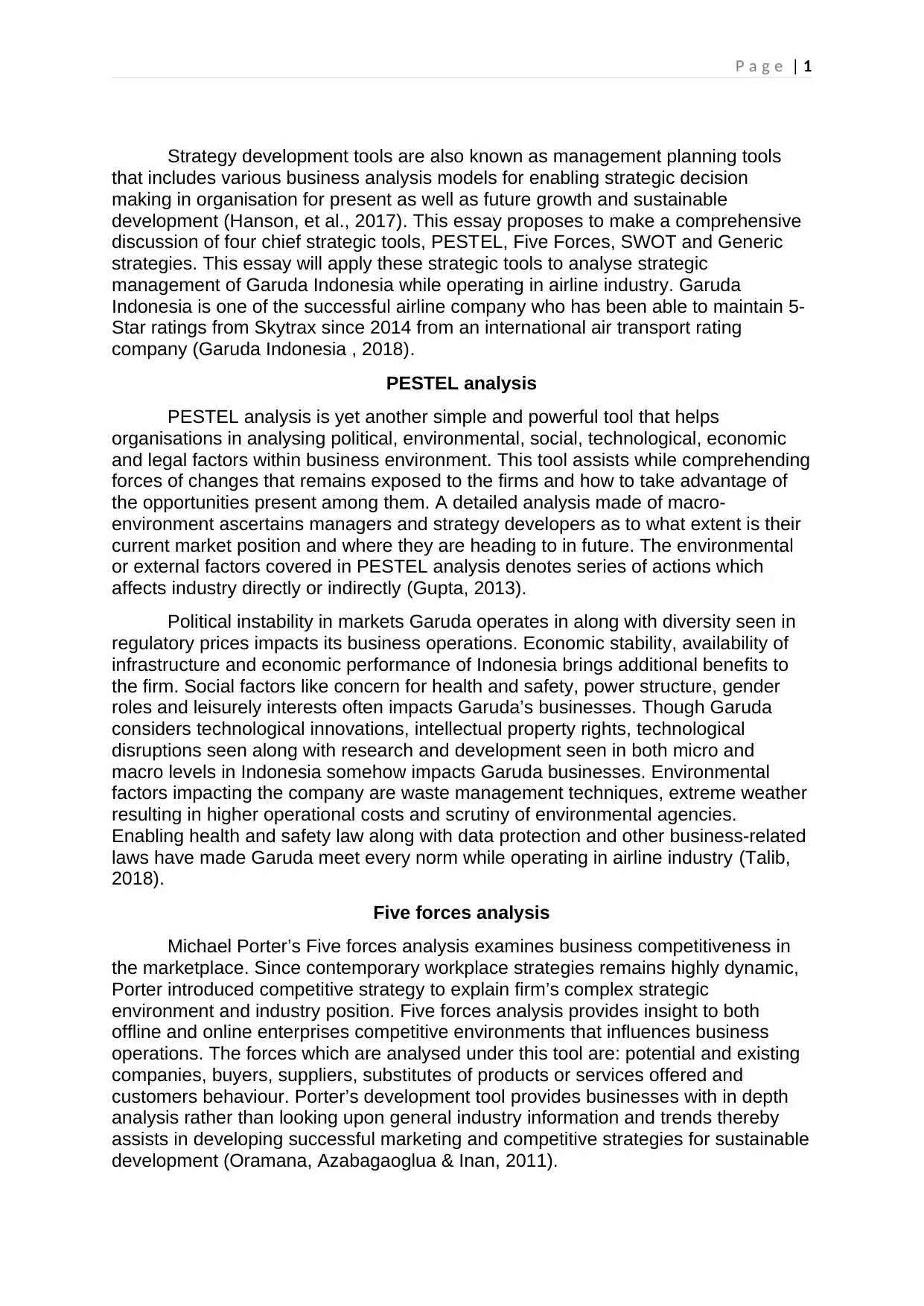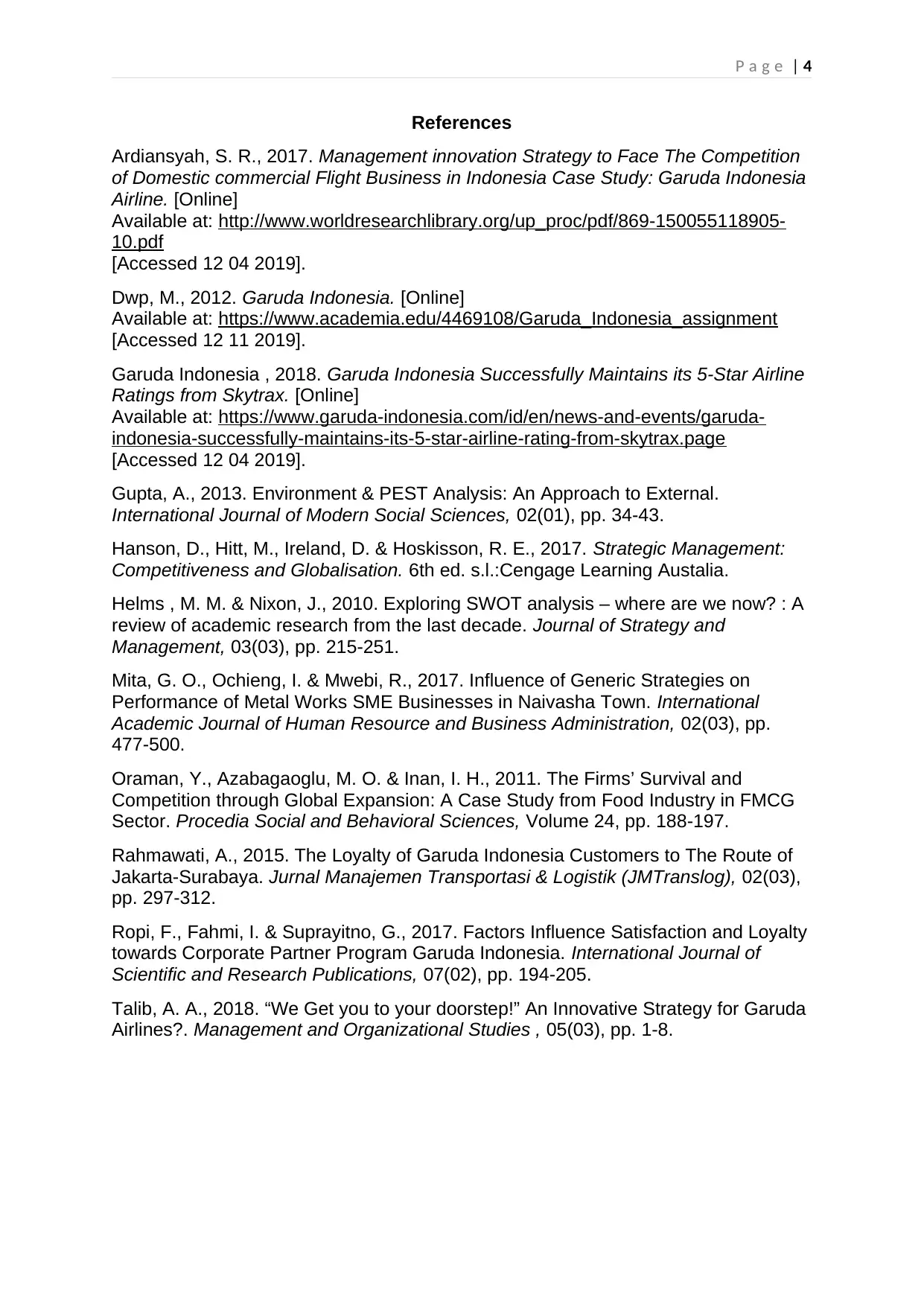Strategic Tools for Garuda Indonesia: PESTEL, SWOT, and More
VerifiedAdded on 2023/01/18
|5
|1631
|69
Essay
AI Summary
This essay offers a comprehensive strategic analysis of Garuda Indonesia, a successful airline company. It applies strategic tools such as PESTEL (Political, Economic, Social, Technological, Environmental, and Legal), Five Forces (analyzing competitive forces), SWOT (Strengths, Weaknesses, Opportunities, and Threats), and generic strategies (cost leadership and differentiation) to understand Garuda Indonesia's position in the airline industry. The analysis covers the external factors impacting the company, the competitive landscape, internal strengths and weaknesses, and potential growth opportunities. The essay also discusses Garuda Indonesia's cost differentiation strategy and its implications. The essay concludes with an evaluation of the company's competitive position and provides insights into its strategic management.

Institutional Affiliation(S)
Competitive Strategy
Garuda Indonesia
Student Name
[Date]
Competitive Strategy
Garuda Indonesia
Student Name
[Date]
Paraphrase This Document
Need a fresh take? Get an instant paraphrase of this document with our AI Paraphraser

P a g e | 1
Strategy development tools are also known as management planning tools
that includes various business analysis models for enabling strategic decision
making in organisation for present as well as future growth and sustainable
development (Hanson, et al., 2017). This essay proposes to make a comprehensive
discussion of four chief strategic tools, PESTEL, Five Forces, SWOT and Generic
strategies. This essay will apply these strategic tools to analyse strategic
management of Garuda Indonesia while operating in airline industry. Garuda
Indonesia is one of the successful airline company who has been able to maintain 5-
Star ratings from Skytrax since 2014 from an international air transport rating
company (Garuda Indonesia , 2018).
PESTEL analysis
PESTEL analysis is yet another simple and powerful tool that helps
organisations in analysing political, environmental, social, technological, economic
and legal factors within business environment. This tool assists while comprehending
forces of changes that remains exposed to the firms and how to take advantage of
the opportunities present among them. A detailed analysis made of macro-
environment ascertains managers and strategy developers as to what extent is their
current market position and where they are heading to in future. The environmental
or external factors covered in PESTEL analysis denotes series of actions which
affects industry directly or indirectly (Gupta, 2013).
Political instability in markets Garuda operates in along with diversity seen in
regulatory prices impacts its business operations. Economic stability, availability of
infrastructure and economic performance of Indonesia brings additional benefits to
the firm. Social factors like concern for health and safety, power structure, gender
roles and leisurely interests often impacts Garuda’s businesses. Though Garuda
considers technological innovations, intellectual property rights, technological
disruptions seen along with research and development seen in both micro and
macro levels in Indonesia somehow impacts Garuda businesses. Environmental
factors impacting the company are waste management techniques, extreme weather
resulting in higher operational costs and scrutiny of environmental agencies.
Enabling health and safety law along with data protection and other business-related
laws have made Garuda meet every norm while operating in airline industry (Talib,
2018).
Five forces analysis
Michael Porter’s Five forces analysis examines business competitiveness in
the marketplace. Since contemporary workplace strategies remains highly dynamic,
Porter introduced competitive strategy to explain firm’s complex strategic
environment and industry position. Five forces analysis provides insight to both
offline and online enterprises competitive environments that influences business
operations. The forces which are analysed under this tool are: potential and existing
companies, buyers, suppliers, substitutes of products or services offered and
customers behaviour. Porter’s development tool provides businesses with in depth
analysis rather than looking upon general industry information and trends thereby
assists in developing successful marketing and competitive strategies for sustainable
development (Oramana, Azabagaoglua & Inan, 2011).
Strategy development tools are also known as management planning tools
that includes various business analysis models for enabling strategic decision
making in organisation for present as well as future growth and sustainable
development (Hanson, et al., 2017). This essay proposes to make a comprehensive
discussion of four chief strategic tools, PESTEL, Five Forces, SWOT and Generic
strategies. This essay will apply these strategic tools to analyse strategic
management of Garuda Indonesia while operating in airline industry. Garuda
Indonesia is one of the successful airline company who has been able to maintain 5-
Star ratings from Skytrax since 2014 from an international air transport rating
company (Garuda Indonesia , 2018).
PESTEL analysis
PESTEL analysis is yet another simple and powerful tool that helps
organisations in analysing political, environmental, social, technological, economic
and legal factors within business environment. This tool assists while comprehending
forces of changes that remains exposed to the firms and how to take advantage of
the opportunities present among them. A detailed analysis made of macro-
environment ascertains managers and strategy developers as to what extent is their
current market position and where they are heading to in future. The environmental
or external factors covered in PESTEL analysis denotes series of actions which
affects industry directly or indirectly (Gupta, 2013).
Political instability in markets Garuda operates in along with diversity seen in
regulatory prices impacts its business operations. Economic stability, availability of
infrastructure and economic performance of Indonesia brings additional benefits to
the firm. Social factors like concern for health and safety, power structure, gender
roles and leisurely interests often impacts Garuda’s businesses. Though Garuda
considers technological innovations, intellectual property rights, technological
disruptions seen along with research and development seen in both micro and
macro levels in Indonesia somehow impacts Garuda businesses. Environmental
factors impacting the company are waste management techniques, extreme weather
resulting in higher operational costs and scrutiny of environmental agencies.
Enabling health and safety law along with data protection and other business-related
laws have made Garuda meet every norm while operating in airline industry (Talib,
2018).
Five forces analysis
Michael Porter’s Five forces analysis examines business competitiveness in
the marketplace. Since contemporary workplace strategies remains highly dynamic,
Porter introduced competitive strategy to explain firm’s complex strategic
environment and industry position. Five forces analysis provides insight to both
offline and online enterprises competitive environments that influences business
operations. The forces which are analysed under this tool are: potential and existing
companies, buyers, suppliers, substitutes of products or services offered and
customers behaviour. Porter’s development tool provides businesses with in depth
analysis rather than looking upon general industry information and trends thereby
assists in developing successful marketing and competitive strategies for sustainable
development (Oramana, Azabagaoglua & Inan, 2011).

P a g e | 2
Although Garuda controls around 50% of domestic market, it has to face
constant competition from rivalries within airline industry (Ardiansyah, 2017). Threats
of new entrants remain weaker as airline industry upfronts huge investments that
makes new companies very difficult for entering into the industry. Threats from
substitutes also remains low as Indonesia do not have high-speed trains that makes
most of the travellers prefer travelling in airplanes. Bargaining power of suppliers
remains relatively high since very few numbers of suppliers are present that provides
Garuda with aircrafts and jets like Boeing and Airbus. Bargaining power of buyers
also remains high as they have the privilege to search for other flights that offers
superior service or low-priced air-tickets (Dwp, 2012). For instance, Lion Air dealing
in domestic flights within Indonesian airline industry. This rivalry company follows
Low-cost Carrier that makes many customer shifts towards it (Ardiansyah, 2017).
SWOT analysis
A SWOT analysis is an effective yet simple tool that helps in developing
business strategies, whether it is a start-up plan or for guiding an existing company.
SWOT stands for: Strengths, Weaknesses, Opportunities and Threats. Strengths
and weaknesses concern internal factors of the organisations and those components
that have been controlled over or requires to be changed like intellectual property,
team members and location. Threats and opportunities deal with external factors of
the company present in wider market. Organisations take advantage of opportunities
while protecting themselves from threats seen, however, changing them is not
covered under SWOT analysis. Examples includes, consumers buying trends,
competitors and raw material prices, etc. (Helms & Nixon, 2010)
Strengths seen in Garuda other than talent management, strong brand
recognition and wider geographic presence is its intention in serving diversified
customer segments within airline industry (Talib, 2018). Weakness of the company
lies in cost of replacing highly expert teams, high turnover of employees and decline
seen in market share value (Ropi, Fahmi & Suprayitno, 2017). Opportunities can be
seen in increased customer base within lower segments, accelerated technological
advances and innovations along with rapid expansion of economy. Threats present
for the company includes distrust seen among institutions, competitive pressures
and shorts killed human resources which might bring challenges for the future growth
(Ardiansyah, 2017).
Generic Strategy
Generic strategy are tools of strategic planning which are adopted by
organisations, irrespective of any marketplace or industry for gaining competitive
position. Porter’s generic strategy framework is one of the most notable among
strategic management related literature which highlights two basic choices of every
firms: cost leadership and differentiation. Cost leadership is based upon managing
and organising functions that brings value-added activities so that it becomes lowest
cost producer within an industry. Differentiation strategy refers to those functions
through which firms persuades customers by making products superior in some or
the other way than offered by competitors (Mita, Ochieng & Mwebi, 2017).
The cost differentiation strategy stresses on those organisational efforts that
enables creation of products or services in relatively lower costs than competitors.
Since, Garuda Indonesia considers prices in buying products and for implementing
cost leadership strategy, the company fulfils all the requirements in two major
Although Garuda controls around 50% of domestic market, it has to face
constant competition from rivalries within airline industry (Ardiansyah, 2017). Threats
of new entrants remain weaker as airline industry upfronts huge investments that
makes new companies very difficult for entering into the industry. Threats from
substitutes also remains low as Indonesia do not have high-speed trains that makes
most of the travellers prefer travelling in airplanes. Bargaining power of suppliers
remains relatively high since very few numbers of suppliers are present that provides
Garuda with aircrafts and jets like Boeing and Airbus. Bargaining power of buyers
also remains high as they have the privilege to search for other flights that offers
superior service or low-priced air-tickets (Dwp, 2012). For instance, Lion Air dealing
in domestic flights within Indonesian airline industry. This rivalry company follows
Low-cost Carrier that makes many customer shifts towards it (Ardiansyah, 2017).
SWOT analysis
A SWOT analysis is an effective yet simple tool that helps in developing
business strategies, whether it is a start-up plan or for guiding an existing company.
SWOT stands for: Strengths, Weaknesses, Opportunities and Threats. Strengths
and weaknesses concern internal factors of the organisations and those components
that have been controlled over or requires to be changed like intellectual property,
team members and location. Threats and opportunities deal with external factors of
the company present in wider market. Organisations take advantage of opportunities
while protecting themselves from threats seen, however, changing them is not
covered under SWOT analysis. Examples includes, consumers buying trends,
competitors and raw material prices, etc. (Helms & Nixon, 2010)
Strengths seen in Garuda other than talent management, strong brand
recognition and wider geographic presence is its intention in serving diversified
customer segments within airline industry (Talib, 2018). Weakness of the company
lies in cost of replacing highly expert teams, high turnover of employees and decline
seen in market share value (Ropi, Fahmi & Suprayitno, 2017). Opportunities can be
seen in increased customer base within lower segments, accelerated technological
advances and innovations along with rapid expansion of economy. Threats present
for the company includes distrust seen among institutions, competitive pressures
and shorts killed human resources which might bring challenges for the future growth
(Ardiansyah, 2017).
Generic Strategy
Generic strategy are tools of strategic planning which are adopted by
organisations, irrespective of any marketplace or industry for gaining competitive
position. Porter’s generic strategy framework is one of the most notable among
strategic management related literature which highlights two basic choices of every
firms: cost leadership and differentiation. Cost leadership is based upon managing
and organising functions that brings value-added activities so that it becomes lowest
cost producer within an industry. Differentiation strategy refers to those functions
through which firms persuades customers by making products superior in some or
the other way than offered by competitors (Mita, Ochieng & Mwebi, 2017).
The cost differentiation strategy stresses on those organisational efforts that
enables creation of products or services in relatively lower costs than competitors.
Since, Garuda Indonesia considers prices in buying products and for implementing
cost leadership strategy, the company fulfils all the requirements in two major
⊘ This is a preview!⊘
Do you want full access?
Subscribe today to unlock all pages.

Trusted by 1+ million students worldwide

P a g e | 3
aspects: organisation and resources. Garuda pricing policy for every route is based
as per ceiling price stipulated by government and therefore, the pricing of the
company does not compete with other low-cost carriers operating in Indonesia.
Since cost strategy do not compete with other airlines, Garuda needs to work upon
its other differentiation strategies like security and safety to ensure that additional
services are provided by the firm (Rahmawati, 2015).
aspects: organisation and resources. Garuda pricing policy for every route is based
as per ceiling price stipulated by government and therefore, the pricing of the
company does not compete with other low-cost carriers operating in Indonesia.
Since cost strategy do not compete with other airlines, Garuda needs to work upon
its other differentiation strategies like security and safety to ensure that additional
services are provided by the firm (Rahmawati, 2015).
Paraphrase This Document
Need a fresh take? Get an instant paraphrase of this document with our AI Paraphraser

P a g e | 4
References
Ardiansyah, S. R., 2017. Management innovation Strategy to Face The Competition
of Domestic commercial Flight Business in Indonesia Case Study: Garuda Indonesia
Airline. [Online]
Available at: http://www.worldresearchlibrary.org/up_proc/pdf/869-150055118905-
10.pdf
[Accessed 12 04 2019].
Dwp, M., 2012. Garuda Indonesia. [Online]
Available at: https://www.academia.edu/4469108/Garuda_Indonesia_assignment
[Accessed 12 11 2019].
Garuda Indonesia , 2018. Garuda Indonesia Successfully Maintains its 5-Star Airline
Ratings from Skytrax. [Online]
Available at: https://www.garuda-indonesia.com/id/en/news-and-events/garuda-
indonesia-successfully-maintains-its-5-star-airline-rating-from-skytrax.page
[Accessed 12 04 2019].
Gupta, A., 2013. Environment & PEST Analysis: An Approach to External.
International Journal of Modern Social Sciences, 02(01), pp. 34-43.
Hanson, D., Hitt, M., Ireland, D. & Hoskisson, R. E., 2017. Strategic Management:
Competitiveness and Globalisation. 6th ed. s.l.:Cengage Learning Austalia.
Helms , M. M. & Nixon, J., 2010. Exploring SWOT analysis – where are we now? : A
review of academic research from the last decade. Journal of Strategy and
Management, 03(03), pp. 215-251.
Mita, G. O., Ochieng, I. & Mwebi, R., 2017. Influence of Generic Strategies on
Performance of Metal Works SME Businesses in Naivasha Town. International
Academic Journal of Human Resource and Business Administration, 02(03), pp.
477-500.
Oraman, Y., Azabagaoglu, M. O. & Inan, I. H., 2011. The Firms’ Survival and
Competition through Global Expansion: A Case Study from Food Industry in FMCG
Sector. Procedia Social and Behavioral Sciences, Volume 24, pp. 188-197.
Rahmawati, A., 2015. The Loyalty of Garuda Indonesia Customers to The Route of
Jakarta-Surabaya. Jurnal Manajemen Transportasi & Logistik (JMTranslog), 02(03),
pp. 297-312.
Ropi, F., Fahmi, I. & Suprayitno, G., 2017. Factors Influence Satisfaction and Loyalty
towards Corporate Partner Program Garuda Indonesia. International Journal of
Scientific and Research Publications, 07(02), pp. 194-205.
Talib, A. A., 2018. “We Get you to your doorstep!” An Innovative Strategy for Garuda
Airlines?. Management and Organizational Studies , 05(03), pp. 1-8.
References
Ardiansyah, S. R., 2017. Management innovation Strategy to Face The Competition
of Domestic commercial Flight Business in Indonesia Case Study: Garuda Indonesia
Airline. [Online]
Available at: http://www.worldresearchlibrary.org/up_proc/pdf/869-150055118905-
10.pdf
[Accessed 12 04 2019].
Dwp, M., 2012. Garuda Indonesia. [Online]
Available at: https://www.academia.edu/4469108/Garuda_Indonesia_assignment
[Accessed 12 11 2019].
Garuda Indonesia , 2018. Garuda Indonesia Successfully Maintains its 5-Star Airline
Ratings from Skytrax. [Online]
Available at: https://www.garuda-indonesia.com/id/en/news-and-events/garuda-
indonesia-successfully-maintains-its-5-star-airline-rating-from-skytrax.page
[Accessed 12 04 2019].
Gupta, A., 2013. Environment & PEST Analysis: An Approach to External.
International Journal of Modern Social Sciences, 02(01), pp. 34-43.
Hanson, D., Hitt, M., Ireland, D. & Hoskisson, R. E., 2017. Strategic Management:
Competitiveness and Globalisation. 6th ed. s.l.:Cengage Learning Austalia.
Helms , M. M. & Nixon, J., 2010. Exploring SWOT analysis – where are we now? : A
review of academic research from the last decade. Journal of Strategy and
Management, 03(03), pp. 215-251.
Mita, G. O., Ochieng, I. & Mwebi, R., 2017. Influence of Generic Strategies on
Performance of Metal Works SME Businesses in Naivasha Town. International
Academic Journal of Human Resource and Business Administration, 02(03), pp.
477-500.
Oraman, Y., Azabagaoglu, M. O. & Inan, I. H., 2011. The Firms’ Survival and
Competition through Global Expansion: A Case Study from Food Industry in FMCG
Sector. Procedia Social and Behavioral Sciences, Volume 24, pp. 188-197.
Rahmawati, A., 2015. The Loyalty of Garuda Indonesia Customers to The Route of
Jakarta-Surabaya. Jurnal Manajemen Transportasi & Logistik (JMTranslog), 02(03),
pp. 297-312.
Ropi, F., Fahmi, I. & Suprayitno, G., 2017. Factors Influence Satisfaction and Loyalty
towards Corporate Partner Program Garuda Indonesia. International Journal of
Scientific and Research Publications, 07(02), pp. 194-205.
Talib, A. A., 2018. “We Get you to your doorstep!” An Innovative Strategy for Garuda
Airlines?. Management and Organizational Studies , 05(03), pp. 1-8.
1 out of 5
Related Documents
Your All-in-One AI-Powered Toolkit for Academic Success.
+13062052269
info@desklib.com
Available 24*7 on WhatsApp / Email
![[object Object]](/_next/static/media/star-bottom.7253800d.svg)
Unlock your academic potential
Copyright © 2020–2025 A2Z Services. All Rights Reserved. Developed and managed by ZUCOL.



